Archive for ‘Cables & Cords’ Category
Cool and Colorful Desktop Solutions to Organize Your Workspace
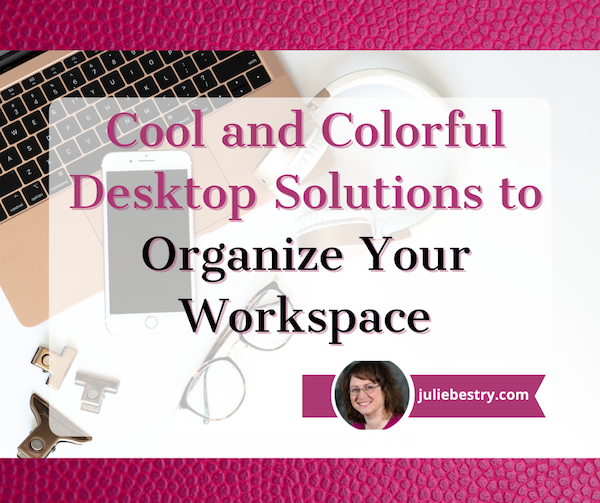
June is odd. In much of the county, school has let out (or soon will) and both kids and teachers have been set free. New graduates are gearing up to start their first jobs, while some workplaces have started to shift to summer hours or half-day Fridays. It’s already in the 90°s for many of us, and mojo is in short supply, but the bulk of us aren’t getting summer vacation.
I have a short series coming up soon about lack of motivation, burnout, toxic productivity, productivity dysmorphia, and ways to beat the psychological obstacles to getting organized and staying inspired. But today, we’re going to look at something a little more lighthearted. Sometimes, a little retail therapy (even just via window shopping) can improve our moods and make us a bit more motivated to tackle our stuff, tasks, and spaces.
So, here are a few of the products I’ve seen lately that made me pause and go, “Hmmm.” Be sure to jump into the comments and let me know what you think!
MOFT INVISIBLE LAPTOP STAND
Sometimes, minimalist products can maximize results.
Whether you’re working at your desk at HQ, from your home office or kitchen table, on an airplane, at a picnic table in the sunshine, or in the corner coffee shop, the ergonomics of your workspace setup is important. When you have a permanent desk, it’s easy to arrange for a monitor riser so that your screen is at the right height, but portable risers can be heavy and inconvenient, and working while mobile can bring unexpected miseries. Wouldn’t it be nice to have something lightweight and easy to maneuver?
Enter Moft, maker of device accessories. They state, “Most productivity accessories are rigid, bulky and heavy-eeping you tied to a specific location. We wanted to create something flexible, functional, and non-intrusive that goes everywhere we go, allowing us to be productive anywhere life’s adventures take us.”
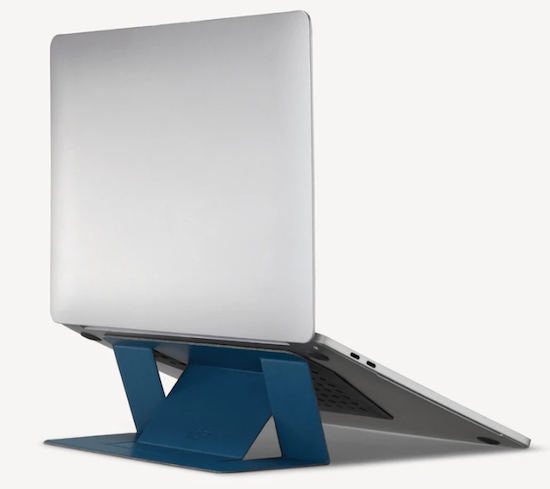
MOFT’s Invisible Laptop Stand is hard to describe but quick to impress. When flat and not in use, it’s ridiculously thin at only 0.1″ thick. It’s constructed out of “vegan” leather (didn’t we used to call that vinyl?) and heavy-duty fiberglass.

When flat, you’d barely notice it, but once attached to the bottom of your laptop (with residue-free adhesive) and adjusted to either of the two possible angles, the 3-ounce stand supports up to 18 pounds of laptop weight.
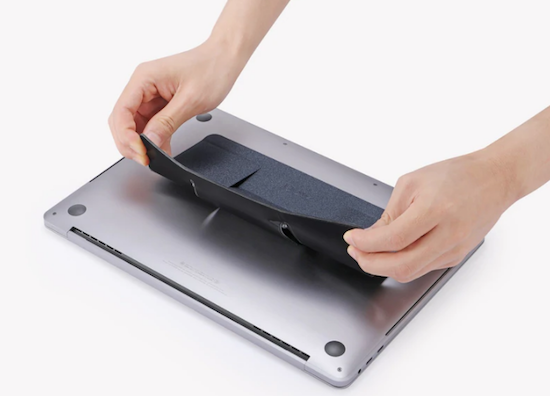
With built-in magnets, you can easily raise your laptop to the right height in a snap. There are two elevation angles to maximize your comfort. Use the “high-lifting” mode when you are sitting, and raise your laptop 3 inches (at a 25° angle); if you’re using a standing desk or working at a counter, consider the “low-lifting” mode of 2 inches to raise your laptop to a 15° angle.

Since it’s lightweight, portable, and (usually) attached to your laptop, there’s no need to create other space in your bag to accommodate it and you won’t have to worry you’ll forget or misplace it.
The Invisible Laptop Stand comes in Silver, Space Grey, Jean Grey (like the character from X-Men), Wanderlust Blue, Sunset Orange, Cool Grey, and Jet Black. (And yes, if you click through the photos at the site, you can see that all those greys really are different.) There are also limited-edition versions, sold two-for-the-price-of-one, in Pink (shown below) and Gold, sold only in the US.
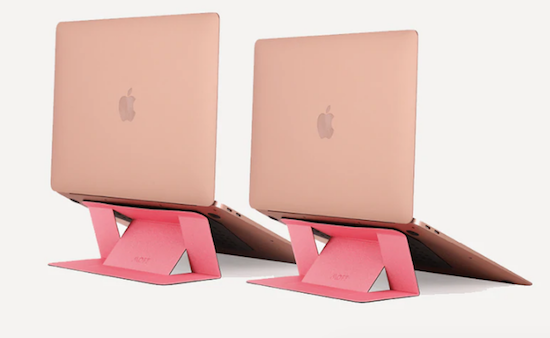
The adhesive is residue-free and can be removed and reapplied (or attached to different computers) up to half a dozen times.
The MOFT Invisible Laptop Stand can be used with laptops measuring between 11.6″ and 15.6″. However, they don’t recommend using it with laptops that have vents on the bottom surface, as the stand would block airflow. For users with laptops with bottom vents, they recommend their non-adhesive version (available only in Silver and Space Grey). Because it doesn’t stick to the back (bottom) of your computer, setup in a twinge slower, but still easy, and works with computers measuring 11.6″ to 16″ (with the exception of 14″ MacBooks, which have little rubber feet).
The adhesive versions of the MOFT Invisible Laptop Stand are $24.99; the non-adhesive versions are $29.99. They are sold directly at the MOFT site; Amazon sells them at the same price, but has a very limited availability of colors.
For those using a multiple-device workspace, note that MOFT also makes stands for tablets and phones.
SPECTRUM WALL HANGER
Are you at the point in your year where you really wish you’d invested in a full-sized wall calendar for planning big-picture projects, but you can’t justify the expense of wasting half a year of calendar pages? Or, if you know there are undated wall calendars, you may be uninspired by them.
Poketo’s Spectrum Wall Planner may be just what you need to brighten your office and your mood.

Each of the twelve pages in this poster-sized wall planner looks like it has made friends with the color schemes at Pantone. (Need a refresher? Read Ask Paper Doll: Should I Organize My Space and Time With Color?) The pages are undated, so you can start planning with your summer months and continue on through to next spring.
While I’d be inclined to post two months simultaneously (this month and next month), Poketo encourages users to decorate your walls with anywhere from 4-12 planner pages to make this a more powerful long-term planning tool. You can use any poster hangers or adhesives you have available, though they do sell an Acrylic Poster Hanger for $32. (At that price, obviously, hanging only one or two pages concurrently would make more sense that a 12-month set.)
The 12 monthly pages each measure 30.0″ x 20.6″ and are made of FSC-Certified tree-free paper to be gentler to the environment. (Unfortunately, the site does not reference whether the paper is made from stone or other materials.)

The Spectrum Wall Hanger is $48. (To be clear, this is not a reusable or dry-erase product; it’s one-and-done, so only invest if you’re craving bright colors to brighten your space.)
Poketo also carries a line of tree-free Geometric Sticky Notes in “Warm” and “Cool” tones for $8 per set to help theme or code your wall planner. The 5″ x 5″ notes sets come with 15 notes per shape and 60 notes per pad.

CABLE WRANGLER
Longtime readers of the Paper Doll blog know that I love magnetic things. Way back in 2014, I sang the praises of the MOS system in Paper Doll’s Cable Conundrums & the MOS: Magnetic Organization System.
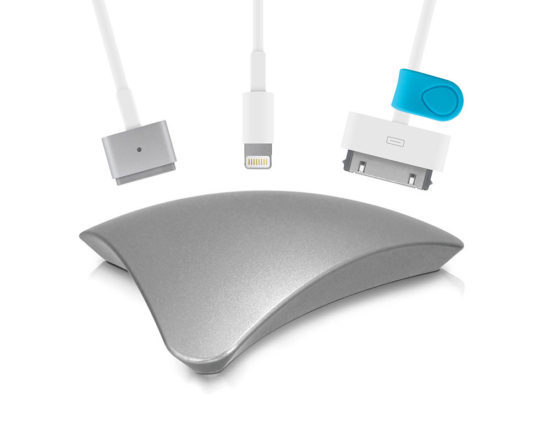
I still use two, a silver aluminum version at my desk to match my Mac products (now silver and purple) and a white plastic version at my bedside, to ensure that when I unplug a lightning (or other) cable from a device, I don’t have to go searching for where it’s squiggled itself away. I loved that it worked horizontally or vertically, and that the price was reasonable.
Sadly, the MOS is no more. Sewell, the company that originally manufactured it no longer lists it, and Amazon, Apple, and all of the other stores that offered it as a solution to cables and cords running amok show it to be unavailable. Sigh. However, while I preferred the triangular, space-age version, I have found a potential replacement in a more parallelogramatic, domed form (3.24″ along each side of the square base).
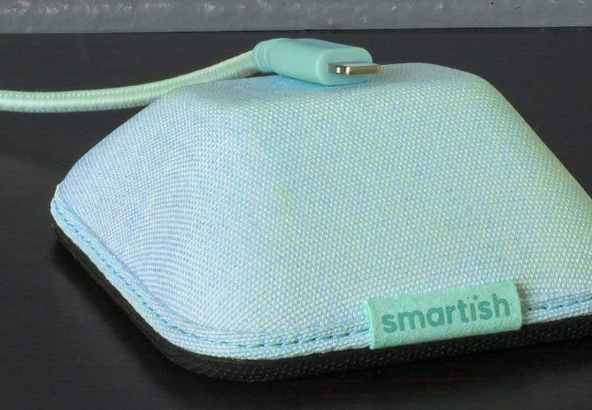
Smartish offers four colorful versions of the Cable Wrangler magnetic cord organizer, and it operates pretty much in the same way as MOS, but more colorfully.
The squat magnetic base is stable and sits neatly on a desk, kitchen counter, bedside table, or gaming station. It comes in one of four cloth-covered designer versions: No. 2 Pencil Grey, Lightly Toasted Beige, Teal Me More, and I’m Blushing. The grey is perfect for that back-to-school collegiate look, while the beige says, “Nancy Meyer-directed movie starring Diane Keaton or Meryl Streep, set on a California or New England beach,” or what GenZ and the Millennials are calling the “Coastal Grandmother” aesthetic. Of course, the pink-toned I’m Blushing was designed specifically for Paper Doll.
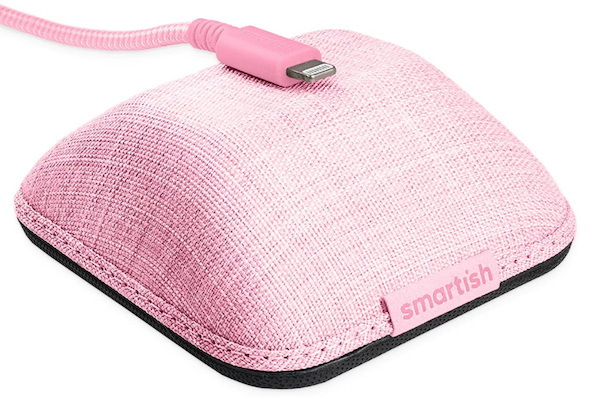
Cables stay put due to magnets, but if your particular cable isn’t feeling very “attractive” (that’s Smartish’s joke, if you don’t like it), you can use one of the three (included) magnetic “collars” (similar to the ones MOS had) to help improve the magnetic attraction and keep the cable stuck to the Wrangler. See it in action, below.
The Smartish Cable Wrangler is available at the Smartish site for $19.99, or with a 6-foot lightning cable and two-port wall charger for $39.99. For those who prefer to shop via Amazon Prime, all versions are $24.99. (Amazon also sells the Cable Wrangler with a cable and wall charger for $39.99.)
MUTESYNC: A MUTE BUTTON FOR YOUR VIDEO CALLS
“Hey, whoever’s dog is barking, can you mute yourself?”
“You’re on mute!”
“You’re still muted!”
Thanks to the pandemic, we’ve been in a Brady Bunch-boxed video conferencing mode since 2020, but doesn’t seem like any of us are getting much better at remembering to mute and un-mute. What we all need is the equivalent of that old Staples’ “Easy Button.”
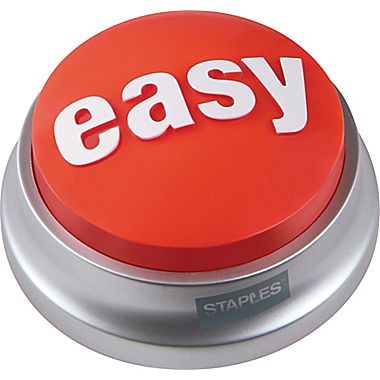
Well, the folks at MuteSync came up with exactly that, an Easy Button for muting/un-muting yourself and for prompting you to pay attention when you aren’t quick to do the right thing.
Instead of rushing your hand to the mouse or touch-screen to wake up the display, make your command icons visible, and click them to change your status, just tap the big, old button on your desk. BAM! MuteSync took their idea to Kickstarter, and it was a huge success! (I mean, of course it was. Seriously, how often do you say/hear “You’re on mute!” in a week?)
When you push the mute button (or even when you mute and unmute from your video meeting platform), the MuteSync mute button light changes! (And, duh, it mutes you.)
MuteSync buttons sync with Zoom, Google Meet, Microsoft Teams, Whereby and (with some hiccups) Discord; as of yet, there’s no love for Butter (my favorite under-appreciated video conferencing app).
Both Mac (from MacOS 10.10 (Yosemite) upward) and Windows (7.7 and above) are supported. Note that if you are using one of the conferencing platforms in the browser, MuteSync only supports Chrome and Brave, not Safari. Also, it does not work with phones or tablets, at least not yet. (But, honestly, finding the mute button on a phone or tablet is even harder, so they need to get on that!)
MuteSync requires the installation of a free, downloadable app, and the button connects to your computer (or hub) via an included USB-C cable.
Tapping the button toggles your mute on and off, and changes color to alert you (and anyone in your workspace) that you are muted (or, yikes!, not muted).
MuteSync users get the “Easy Button,” but also get an extra bonus, a free virtual mute button that lives in the menu bar at the top of the Mac or in the Windows system tray. The virtual button stays in sync with whatever’s going on with your conferencing platform, so if you’ve hit the mute button in Zoom, or tapped the MuteSync mute button, or even if the host has muted you (don’t worry, I’m sure she muted everyone but the speaker, so don’t take it personally!), the virtual button will work in lockstep.
The durable plastic MuteSync mute button is 2.4″ square and 0.4″ high, taking up minimal desk space. The bottom has a rubber pad to ensure that it grips the desk tightly and doesn’t go sliding around.
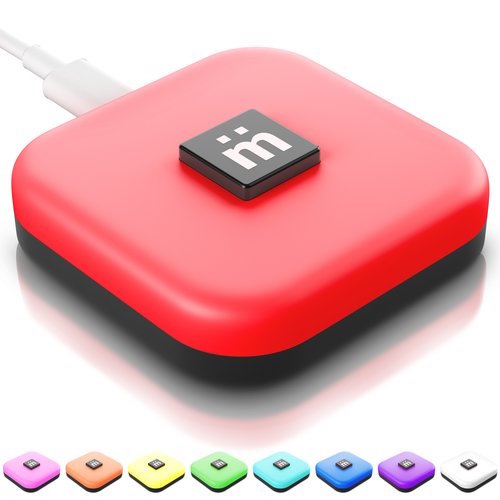
Because different people have different ideas of which colors mean on and off, you can customize the colors and brightness levels of the button’s eight LED light options.
You’ll still have to train your kids, your spouse who acts like a kid, and your exuberant pets so they understand which colors mean they should “shush”. And, if you’re like my peeps on my Friday night professional organizers call (you know who you are!), you may have to train your kitties to avoid stepping on the buttons when they think they’re the stars of the show.
Take a peek at the MuteSync video, and surf around the website, which has a variety of support videos and is written by folks with a fun, goofy sense of humor.
The MuteSync button is $49 at their website, as well as at Amazon.
While this is great for conferencing, I periodically have to record videos on Zoom, and I’ve got a horrible habit of narrating to myself (not-quite under my breath) when I have to switch from video to screen sharing, and when I have to pause in between steps. Yes, editing would allow me to deal with all of that, but I’m not always so technologically savvy (or inclined) with video editing; being able to quickly hit “mute” before before doing any fancy clicks would save me quite a bit of frustration.
What do you think? Could you use a portable, practically invisible, laptop stand? An attention-getting calendar? A fashion-forward cable organizer? An Easy Button to mute and un-mute your video calls?
Please share in the comments and let me know what you think, and what features or colors you wish had been included?
On the Road Again: Organize Your Mobile Office
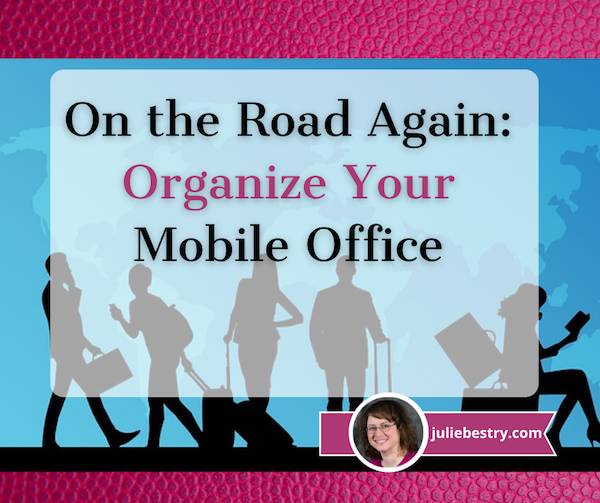
Road Warrior Image by Mohamed Hassan from Pixabay
During the last two years, the watchword has been “work from home.” In this recent WFH era, we’ve eschewed office buildings and turned snuggly corners of our bedrooms and dining rooms into home offices. Many companies have closed their local operations altogether, finally trusting that there’s no need to micromanage their knowledge-worker staffs. More and more, companies are OK with letting people work where and how they operate best.
Of course, this isn’t the case with everyone. Some employers are rushing at breakneck speed to return the North American workplace experience to “normal,” despite the distinct rise in European and Asian COVID cases of the Omicron BA.2 subvariant. Count me as one of those who is curmudgeonly aghast at the state-by-state dropping of precautions, as I noted in the following reply to a friend, which got a lot of Twitter love.
I am so tired of people saying it’s over because they want it to be over. It’s not a relationship, it’s a virus.
— Julie Bestry, CPO® (@ProfOrganizer) March 23, 2022
Obviously, though, there are some people who can’t work from home. Your favorite restaurant can’t let the sous-chef work from his back deck. An OB-GYN is the perfect example of how you can’t phone in every kind of delivery!
And people who travel about for work, whose very career depends on them physically arriving at different locations, whether locally, regionally, nationally, or internationally, need to get on the road (or the tarmac), however ambivalent they might feel about the prospect. And, of course, they need to be organized.
HOW TO ORGANIZE YOUR MOBILE OFFICE
From smart phones to Zoom to cloud computing, modern technology has made road warriors a little less embattled, but keeping your mobile office from looking like an outtake from Game of Thrones battle requires some special equipment and finesse.
Over twenty years as a professional organizer, I have worked with a wide variety of clients who work, at least some of the time, from the road.
There have been numerous pharmaceutical sales representatives who needed to organize medical literature, promotional materials, medication samples, durable medical goods, and anatomical models and schlep them from medical offices and hospitals in their assigned local or regional areas. I’ve worked with a few mobile pharmacists serving as pharmacy supervisors, traveling each week to different outlets, and working both as members of their profession and in consultant/supervisory capacities on behalf of their companies.
I had one client who traveled her “territories” in various parts of the country for a restaurant chain, training franchisees and their staff on everything from computer systems to how to prepare and garnish certain delicious foodstuffs. And one client shared memorable tales of his experiences as a high-level insurance executive assigned to travel and review high profile claims.
What all of these hearty folks had in common is that they needed to have all of their necessary office supplies, documents, and resources available to them with the same ease of accessibility as when they were comfortably seated in actual offices. While each had unique needs, their were a wide number of commonalities.
In the Car
Let’s focus on documents. Back at a decidedly stationary office, you’d have filing cabinets, hanging file drawers in a desk, and a variety of other options with the distinct advantage that you never need worry about jostling.
Cars, however, jostle. They are buffeted by the wind on the highway and hit unanticipated bumps from potholes and running over detritus that has fallen off of other vehicles.
If your mobile office requires bringing lots of glossy literature, forms, or other pre-printed material, you’ll want to approximate a standard filing system as much as possible.
Personally, I’m a fan of sturdy file crates. These crates, fashioned after old-school milk crates but with file rails on all four sides (to accommodate letter-sized or legal-sized files) take a licking and keep on ticking when you’ve got a heavy load of hanging files filled with file folders and lots of paper.

My favorite version is made by Sterilite and, like the very best versions of the TARDIS’s control room, has lots of “round things.” I own them in four different shades of pink/plum/mauve, plus blues and blacks. Another client swears by teal.
In most “big box” stores like Target or Walmart or office supply stores, you can usually fine single crates for $5-10. (Storex makes a very similar version, with weirder displays of “round things,” but usually only in packs of three or more for somewhat higher prices.)
Paper Doll Carries On About Everyday Carry: What’s In Your Bag?
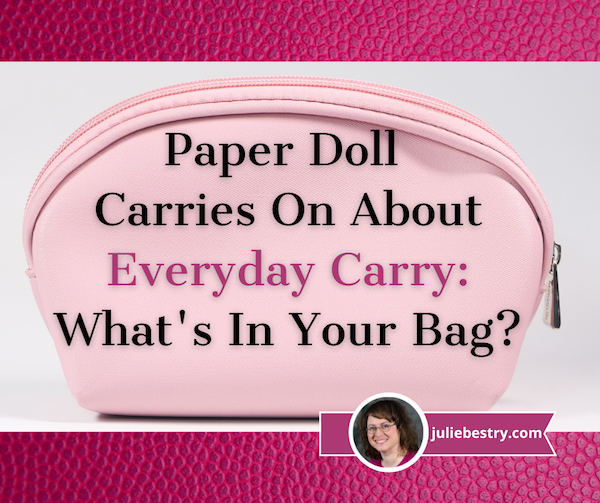 Are you familiar with Everyday Carry? Yes, it sounds more like a branding title for a line of messenger bags than an entire movement that ranges from “the things you schlep each day” to a massive platform for self-identification. But it is both the latter and, to a less dangerous degree than some political affiliations, very much the former.
Are you familiar with Everyday Carry? Yes, it sounds more like a branding title for a line of messenger bags than an entire movement that ranges from “the things you schlep each day” to a massive platform for self-identification. But it is both the latter and, to a less dangerous degree than some political affiliations, very much the former.
WHAT IS EVERYDAY CARRY (EDC)?
When I first heard of the term “everyday carry” about a decade ago, I was reading Kevin Kelly’s superb Cool Tools blog. The blog is really aptly named, as it’s a smörgasbord of, well, really cool — and usually inexpensive — tools for solving life’s problems. It’s like having a circle of really resourceful friends writing about their latest finds.
I’d happened upon the blog via one or another random newsletters that had mentioned Kelly’s “What’s In My Bag?” section of his blog, which often hinged on average people (or possibly semi-famous people I didn’t recognize) talking about their organizing-related products and systems.
The above term “bag” should be taken loosely. For example, a recent post by writer and photographer Nicole Harkin answered, “What’s In My Drawer,” with a variety of oddities in her kitchen drawer. Sometimes, the bag is a larger space, like Chris Askwith’s “What’s In My Workshop?”
And another subset of the kinds of cool tools list appearing on the blog would be “everday carry” pocket tools: small pens, tiny versions of flashlights, pocket knives, itty-bitty compasses and levels, pry bars, battery chargers, multitools, carabiners, S-biners, miniature lighters, and all manner of things that good scouts might carry to be prepared.
It seemed quaint when I first noticed these occasional posts, but the more I surfed the “technology bro” corners of the web over the years (as productivity and technology realms often overlap), the closer a look I got at some of the trends in this area.
A tech friend who spends a lot of time on his bike told me that outdoorsy types (already, a category of human unlikely to cross paths with indoorsy Paper Doll) who biked, hiked, camped, and did similar activities where bugs and crawling/biting things live, tended to hang out in online forums to talk about the stuff they “carried” daily.
As in, things they carried every day when they were taking the subway or getting cake in the break room or flying to conferences in Pittsburgh or Dubuque, generally indoors, where they had no need to start life-saving fires, send an SOS, or rig a floatation device out of their cargo pants!
In the summer of 2019, before the pandemic meant that we were all at home and didn’t need to carry anything a greater distance than from the couch to the kitchen, Vox‘s Stephen T. Wright (not to be confused with the comedian Stephen Wright, who would likely have a bizarre field day with the topic) wrote, Meet the Men Obsessed with Carrying All the Right Stuff.
For some people, EDC (as those in the know apparently call it) is all about being prepared for any and every eventuality, in a scoutmaster-approved manner. But for others, it can become a realm of competition; instead of buying the fanciest car or the newest phone, some folks seek out the teeniest, weeniest “thing” that can do the most stuff. Hence, for example, all the different types of multitools.
I’ll leave you to the Vox article to explore the EDC subcultures, which tends to be predominantly male, knife-heavy, and painted in black or camouflage-adjacent colors; less often, they are miniaturized and as geeky as possible. In some corners of the web, GQ-friendly stylings are also popular. If you want to explore the concept, you can visit:
- The @EverydayCarry Twitter Account
With a solid and versatile set of #EDC tools at his disposal, Adolfo can keep most of his bases covered on weekends without packing too much gear.https://t.co/g4cvteatpF pic.twitter.com/l8hkuxYiqJ
— Everyday Carry (@everydaycarry) March 11, 2022
- Everyday Carry review website
- Carryology Blog
- The Gear Journal
- Urban EDC Supply
- EDC Blog
- The Manual’s Beginner’s Guide to Everyday Carry
WHAT’S MISSING FROM THE EDC ARENA?
Over the past decade, I’ve seen the references to everyday carry expand to the point that many of the design and technology blogs and accounts I read have regular everyday carry features. What do they all have in common? I note three things:
- A focus on tiny metal objects
- A focus on efficiency and preparedness at all costs
- A focus on the needs (and wants) of dudes
Before you tell me that women need the same things on a daily basis as men, I’ll stop you. All of us who grew up on 1970s television shows, boys and girls, expected that at some point we’d have to save ourselves from quicksand. We were prepared equally. But for the reality of our modern lives?
Yes, men and women have similar survival needs for making it through a day of hiking or white water rafting. But a day in the workplace? A walk through a parking garage at night? Not so much.
How many men do you know who carry pepper spray, a rape whistle, or one of those doohickeys where you pull out a tab and a horrendous, high-pitched alarm goes off?
When you look around, whom do you generally see carrying diaper bags? Who is blowing the noses of tiny humans with their inexhaustible supply of tissues? Who is prepared for rest rooms that have no soap or toilet paper?
Who is carrying the aspirin and tummy meds, the bandaids, the emery boards (for snagged nails), the extra masks, not just for ourselves, but because they’re are more likely to be the guardians of not only their own kids, but their kids’ friends and even random strangers?
The not-dudes.
My point isn’t that the male-centric EDC communities are bad, just that the competitive, posturing nature of some sub-groups can be a bit silly.
Preparedness is good. There just don’t seem to be many communities where the people coming together to talk about women’s EDC needs are discussed.
That doesn’t mean there aren’t resources. I’ve gathered some EDC articles written especially for women. These pieces have great tips for hiding your cash (in places dude-thieves are definitely not going to look), dealing with hygiene emergencies, and protecting personal safety, as well as coping with the universal 21st-century problems like a dead phone battery or the need for an itty-bitty flashlight.
Primal Survivor’s Women’s EDC Checklist: 17 Survival Items to Carry Every Day
Pew Pew Tactical’s Best Everyday Carry (EDC) Items List For Women
Tactical.com’s EDC Gear Women Should Never Leave Home Without
Everyday Carry Experts’ These EDC Items Should Be In Any Woman’s Purse
WHAT ABOUT THE EVERYDAY EVERYDAY CARRY?
So, let’s move beyond the emergent and urgent needs of so-called everyday carry. What about the plain old quotidian things we actually need to carry?
I’ll be honest, I can’t figure out why Paper Mommy‘s purse is so heavy. She’s been searching for the perfect purse since the Eisenhower administration, and I’ve accompanied her on a variety of purse-shopping adventures, so I know her requirements for inside and outside zippered compartments, pockets, and divided sections. What I can’t figure out is why it weighs more than my friend’s toddler (when he’s wearing a full-on snowsuit and boots).
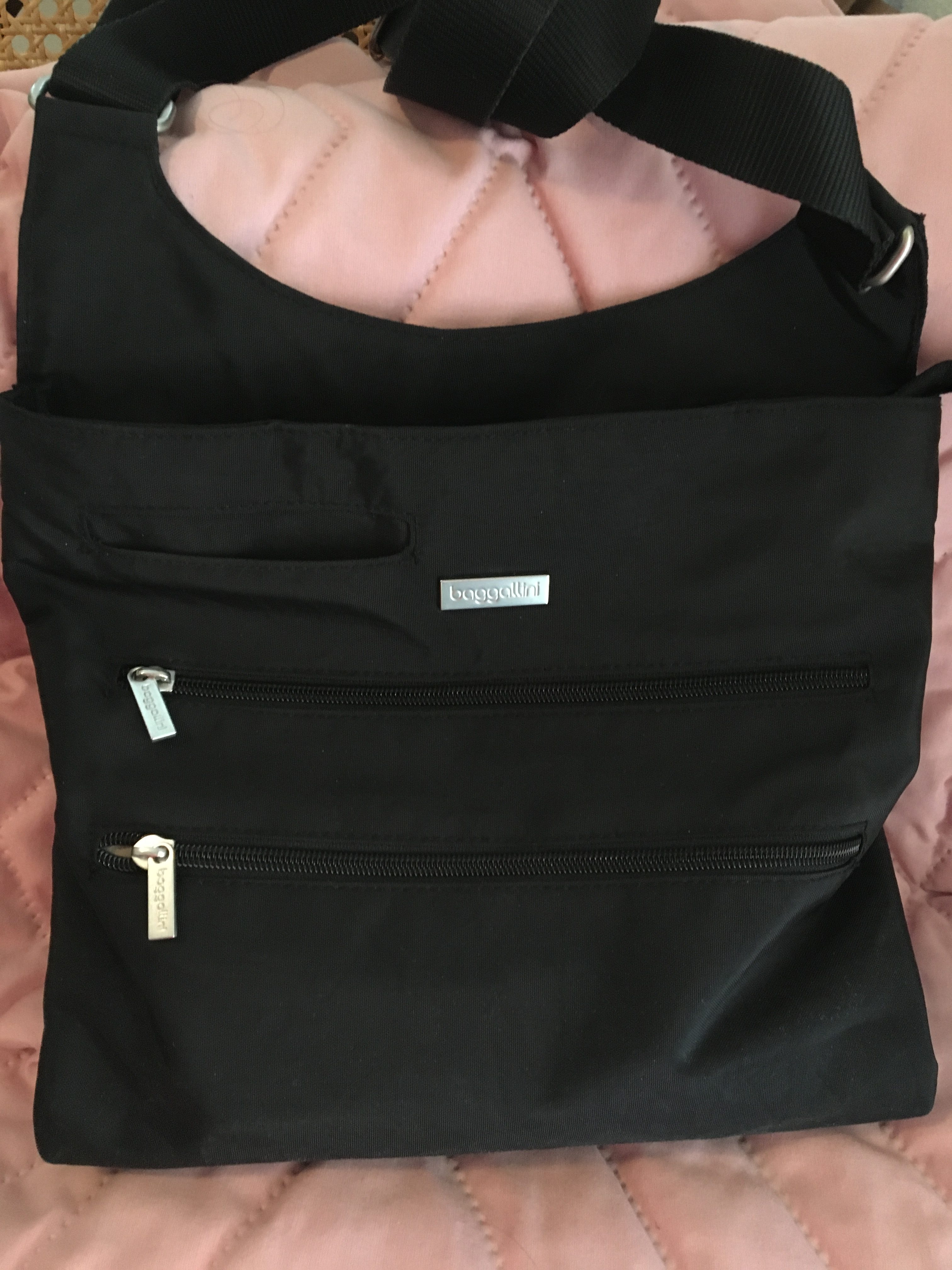
(After this Baggalini cross-body purse got me through two weeks in Italy, I realized that it was the ideal bag for everyday living. BTW, to nobody’s surprise, Paper Mommy picked it out.)
My own personal everyday carry is probably typical for a woman sans tiny humans, and doesn’t involve most of the things recommended in the articles above. I keep my phone charged, trust my car charger, and have my AAA card in my wallet and the app on my phone.
I probably can’t MacGyver much, but with the exception of the time Paper Mommy dropped her keys down the elevator shaft and we had to call upon the ingenuity of someone with rare Earth magnets and an approximation of a fishing pole, I’ve rarely needed much more to survive a typical day than the items in my purse, catalogued just now as:
- Cell phone
- Wallet
- Keys
- Business card case
- Compact (e.g., face powder, for the younger readers)
- 2 lipsticks
- Eyeglass case
- Hair scrunchie
- KN95 mask
- Stack of Starbucks gift cards (because people keep giving them to me as gifts and I almost never go there, so I give them to unhoused persons when it seems someone could really use a hot beverage or a meal)
- Individually-packaged antibacterial hand wipes (which I carried pre-pandemic)
- Tiny satin cosmetic bag for corralling hand sanitizer (and ensuring it doesn’t leak into my purse), ear buds for my phone, half a stack of pink Post-it® Notes, and a pen (so I don’t have to touch the pen at the reception desk in the doctor’s office or when signing a credit card slip).
My purse is a fairly light, but I’m no minimalist. I check a bag for every flight, and plan multiple outfits of every day of any vacation. When I was younger, I tried going out with just an ATM card and driver’s license tucked into my business card case, a lipstick in my pocket, and keys on a coiled bracelet. I felt naked.
WHAT ABOUT A PROFESSIONAL ORGANIZER’S EVERYDAY CARRY?
Ah, now there you’ve got me. My everyday carry for my in-person work with clients is a masterwork of precision. It’s the perfect combination of bag and contents.
When I first read Geralin Thomas‘ post ZÜCA Takes The Lug Out of Luggage, I was intrigued by her dazzling review ZÜCA‘s products. (Rolling suitcases with drawers and a built-in seat? Sign me up!)
The next time I saw Geralin, she was stopping traffic at the NAPO conference expo with her gorgeous ZÜCA Business Backpack.
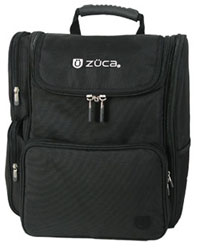
Within weeks, I owned one too, and it looks and works pretty much as it did 13 years ago. If anything (heaven forbid) ever happened to it, I’d get another one exactly like it without a second thought.
So, what makes the ZÜCA Business Backback so nifty as an everyday carry (for all my EDC essentials)?
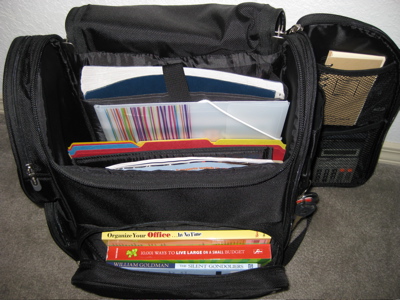
A lower-front zipped portion that, once unzipped, opens toward the user, like a glove compartment or an oven door. It’s suitable for small gadgets, but ideal for hardcover or paperback books you’ve selected to read on the plane or train. It’s also the perfect size and shape to stow your ticket, itinerary and other travel documents.
For my everyday carry, it’s stocked with my ancient Brother P-Touch PT-65 label-maker (20 years old and it keeps on ticking, but nowadays you’d want the PTD210) and some 12mm black-on-white label maker tape.
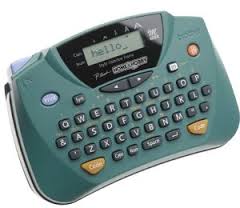
That compartment usually holds index cards and sticky notes for helping temporarily label client’s sorted paper piles, a small toiletry kit with a toothbrush, mini-toothpaste, and other hygiene tiems, and my Anker PowerCore5000 Portable Charger.
NEET & Cozy Cables: A NAPO 2015 EXPO Organizers’ Choice Award Winner
Everybody complains about cable storage. You can’t swing a lightning cable without hitting a blog post or video or Pinterest page on keeping cables untangled, separated, and safe, whether via retail products or DIY methods. For example:
- Paper Doll’s Cable Conundrums & the MOS: Magnetic Organization System
- Organizing the Cords Under Your Desk! by Helena Alkhas
- Cords and Cables and Labels and Controlling the Cables: 3 Novel Solutions by Jeri Dansky
- 10 Ways To Get Cables Under Control by Gina Trapani
- Organize, Store and Buy Computer Cables Wisely by David Caolo for Unclutterer
- How To Tame Cable Cord Chaos (video) by Lori Marrero
- Untangle Your Life: Living Organized With Cables and Cords by Apartment Therapy
- 61 Clever Cord Organizers
However, most of the standard stabs at keeping cables and cords organized seem to focus on cables that stay put in your home or office. Other than Paper Doll-recommended Grid-It!, a past NAPO EXPO fan favorite, we rarely see much about how to corral cables in transit so they don’t get tangled in our book bags, purses and when we’re on the go. Happily, the NAPO 2015 Annual Conference and Organizing EXPO had an exciting new entry in the world of cable organization.
NEET Cable Keeper
(©2015 Julie Bestry. Peter Chin, founder of NEET Products.)
Winner of the 2015 Organizers’ Choice Award, the NEET Cable Keeper is the equivalent of a tea cozy for your cables, if your tea cozy were crossed with a hoodie crossed with a corset. Each long, colorful strip of cloth material — NEET calls it a “shell” — isolates a single cord or cable from any other, and then includes these essential features:
Zipper — Here’s where the hoodie action comes in. There’s no threading your cable or cord through a complicated maze of plastic molding. (If you’ve ever tried to replace a drawstring in a pair of sweatpants, you know how frustrating that can be. Yes, you can attach a safety pin to guide the string, inch by inch, but ARGGGGGHHH, just recalling that makes Paper Doll grumpy.) Merely lay the cord or cable down across the NEET Cable Keeper and zip it up!
The bottom of the shell is flared, which allows you to encase larger USB ends, and it has ample space for multiple cables to be enclosed.
Structured Wire — Sewn into the length of the cloth strip is a bendable wire, much like the stays in a (modern) corset, that provide support stiffness and support. The structured wire services two purposes:
- It protects your cables and cords from damage. There’s no chance you’ll repeatedly fold your cord so tightly that the plastic coating will wear away, or accidentally crush it in a slammed filing cabinet drawer, damaging the delicate internal wires.
- It provides support for the whole cable or cord, making it suitable for wrapping neatly around your wrist as a bracelet, turning it into a loose necklace, or otherwise, bendy, gooseneck-lamp-style, making it beautiful as well as useful. NEET’s website even shows how to bend it into a stand for a smartphone.
Colorful Wardrobe — The NEET Cable Keeper comes in a variety of colors, so you can tell at a glance from across the room whether the cable you’re spotting is your Kindle charger or your Apple Lightning cord. The NEET Cable Keepers come in black, blue, gold, green, light blue, pink, red, purple, silver, white and yellow.
After you zip your cable cozily into the NEET Cable Keeper, like a toddler into a snow-suit, you’re set. It becomes part of the cable itself, so you have no additional pieces to carry or potentially lose; there’s no reason to take it off, unless you’re one of those people who likes to change the colors of your accessories on a daily basis. (Really, stop that.)
Take a peek:
You can get the Keeper two ways, both designed for mobile device cables measuring 3 feet (or about 100cm) or longer and 1/4″ in diameter. If your cable is longer than 3 feet, the width of the Keeper will accommodate you gently folding it before zipping it up.
- NEET Cable Keeper M, with just the Keeper, is $12.
- NEET Cable Keeper M with either a Micro USB cable or an Apple Lightning cable is $18.
It’s available directly from the NEET, and via Amazon, The Grommet and a few other retailers.
Although they are not yet available for purchase, NEET is developing a line of cable organizers for ear buds, laptops, home entertainment, and professional use such as for DJ’s and audio/visual work.
If you own a business and think it would be cool to brand these NEET Cable Keepers for your own customers, NEET founder Peter Chin says, “The NEET Cable Keeper is customizable! We can customize NEET for you to promote your company, event, and brand. Great for corporate giveaways, employee retention programs and brand awareness. Send us a message and we will gladly connect you to our authorized customization partners.”
Zip, wind and organize. Neat (I mean, NEET), eh?




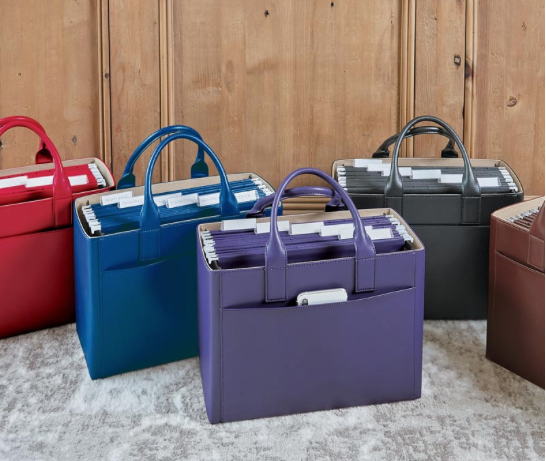




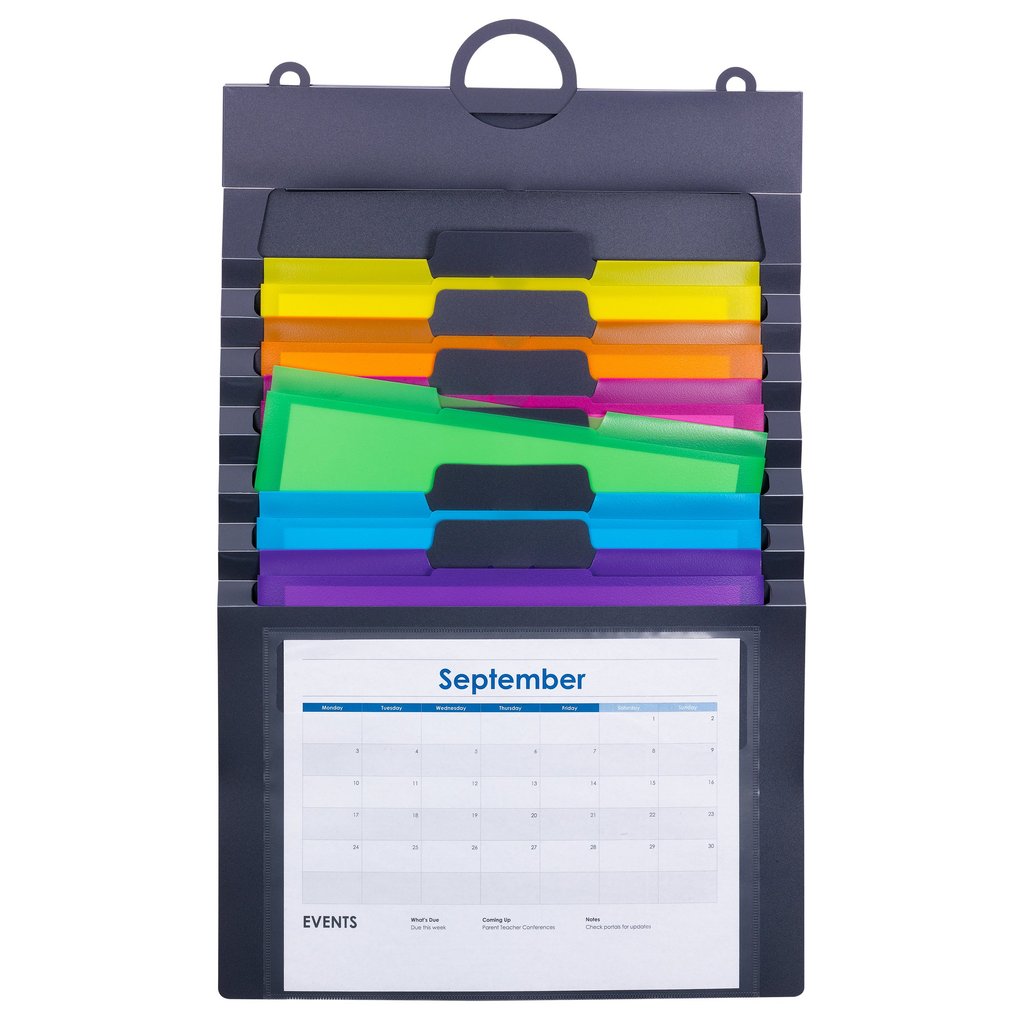
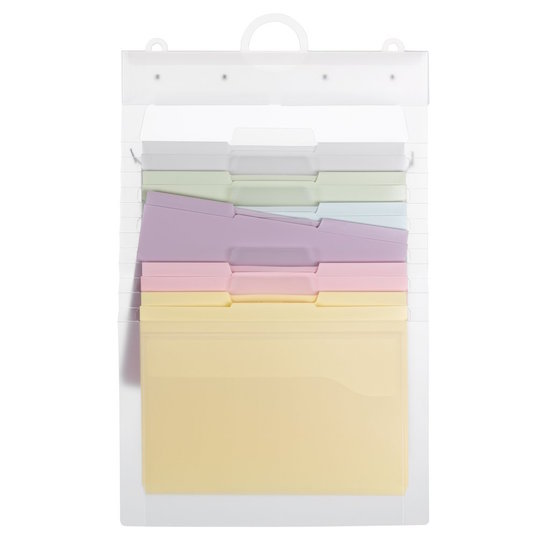
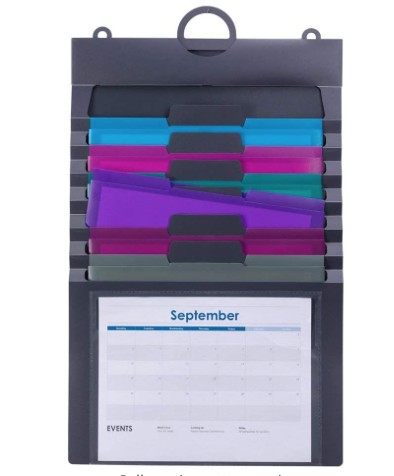
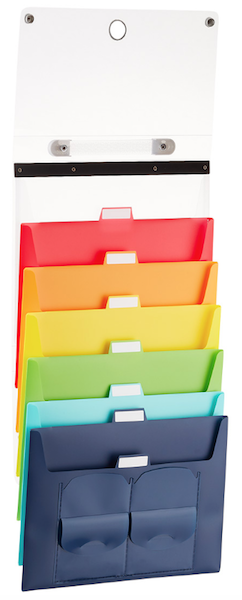

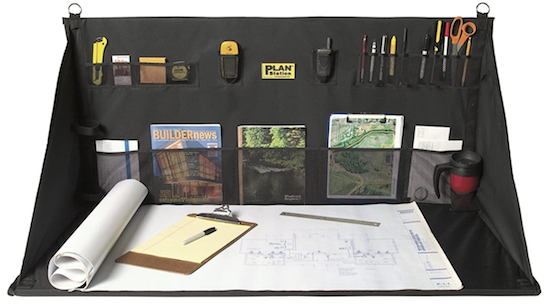







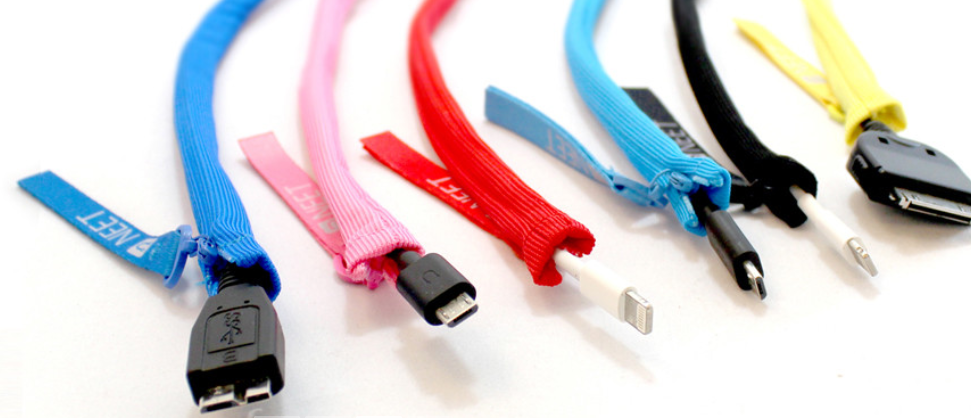
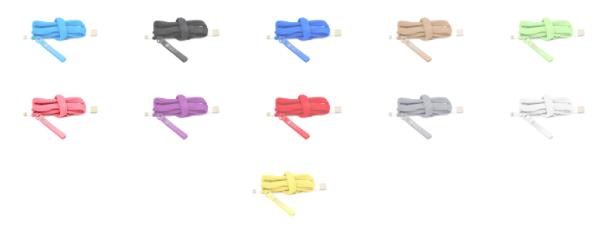



Follow Me